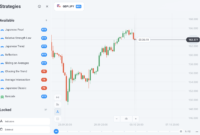Operatorkita.com – Stochastic RSI or commonly called StochRSI is an indicator used in technical analysis with a range between zero and one (or zero and 100 on some platforms). As the name implies, this indicator applies the Stochastic oscillator formula to the RSI value.
StochRSI was developed by Tushar S. Chande and Stanley Kroll published the New Technical Trader in 1994. At that time, there were already technical indicators that showed overbought (overbought) and oversold (oversold), but they still developed StochRSI to improve sensitivity and create more signals than technical indicators in general.
Important points in StochRSI:

When using numbers 0 and 1, the StochRSI above 0.8 is overbought, while numbers below 0.2 are oversold. If using a scale of 0 to 100, above 80 is overbought and below 20 is oversold.
Overbought (overbought) does not mean the price will turn down and vice versa oversold (oversold) does not mean the price will turn up.
Overbought and oversold are RSI readings against the current state of prices.
The number 0 means that the RSI is at its lowest level for the last 14 periods (14 is the default period). A reading of 1 or 100 means that the RSI is at its highest level for the last 14 periods.
Other numbers in the StochRSI indicate a high or low RSI reading.
RSI Stochastic formula
Description:
RSI = RSI reading
min [RSI] = the lowest RSI reading during the specified period
max [RSI] = highest RSI reading during the specified period
Stochastic RSI indicator display
Stochastic RSI consists of two lines that rise and fall on a scale of 0 to 100 (or 0 to 1). In addition to the overbought and oversold limits, there is also a middle value at 50 (or 0.5).
The middle value of 50 (0.5) can be used to identify the short-term trend taking into account the context of the oscillator. When the RSI value is above 50, the instrument can be considered an uptrend, and vice versa.
StochRSI can also be used as a confluence or complement to other indicators to improve accuracy. In addition, StochRSI can be paired with non momentum indicators such as Accumulation Distribution (A/D) as they do not overlap and provide insights from different perceptions.
Late Post :
- Así fueron los millonarios cambios EXTREMOS de estos Reguetoneros vídeos
- Oviya Video Viral Link Original
- Fotos de la fiesta de puff daddy sin censura
- Viral !! Inilah Link Video Guru dan Murid di Gorontalo
- Viral Lucinta Luna Dapat Panggilan ‘Spesial’ dari Youtuber Speed
How to trade the Stochastic RSI
One of the most effective ways of using the Stochastic RSI indicator is to combine it with the ongoing trend. Trending market conditions make overbought and oversold signals in the direction of the trend more accurate.
To better understand its application, here are some examples of how to trade with the StochRSI indicator.
- Uptrend Conditions
On the gold (XAU/USD) chart below, the market is in an uptrend. This is indicated by the presence of a new high that is higher than the previous high (higher high), and a new low that is higher than the previous low (higher low).
With an uptrend condition, the entry that will be taken is buy when oversold. The buy signal enters when the StochRSI figure is below 20 and begins to rise above 20.
Next example, consider the bitcoin (BTC/USD) chart below. Uptrend conditions on the Bitcoin chart below. A new high that is higher than the previous high (higher high) and a new low that is higher than the previous low (higher low) confirm an uptrend.
In this case, the position to be taken is buy. Buy entry is entered when the RSI stoch number shows oversold or below 20 and starts to rise above 20.
- Downtrend Conditions
On the chart of the Pound Sterling currency pair against the US Dollar or GBP / USD below, the ongoing trend is down. This is indicated by the existence of the lowest price lower than the previous (lower low) and the highest price lower than the previous highest price (lower high).
You can see how effective this indicator is when used in trending market conditions. In this case, the given sell signal becomes more accurate and the potential profit offered is greater.
We go to the next example, the chart of the Australian dollar currency pair against the US dollar (AUD/USD). An ongoing trend is a downtrend because it forms lows that are lower than the previous low (lower low), and highs that are lower than the previous high (lower high).
The sell signal enters during overbought conditions or when the StochRSI figure is above 80 and begins to decline below 80.
In the chart above, the sell signal occurred only twice, but the potential yield given is quite large.
Difference between Stochastic RSI and RSI
With the appearance and concept of oversold and overbought that are almost similar, you may be confused between StochRSI and RSI. The difference between the two indicators is the formula. The RSI is a derivative of the price, while the StochRSI is a derivative of the RSI. So, StochRSI is the second derivative of the price.
One more key difference of the two is the speed of movement. The StochRSI moves very quickly from overbought to oversold and vice versa, while the RSI moves more slowly. This does not mean that the StochRSI is better than the RSI, and vice versa.
ads
Disadvantages of Stochatic RSI
One of the drawbacks of the StochRSI is its tendency to be highly volatile; moving too quickly from bottom to top or vice versa. To reduce volatility, use the Moving Average of the StochRSI values. By using the 10-period Simple Moving Average (SMA) of the StochRSI, the reading will be smoother and more stable.
In addition, the StochRSI is the second derivative of the price. In other words, the reading means two steps from the price being analyzed, which means that this indicator is sometimes out of sync with the market price.


